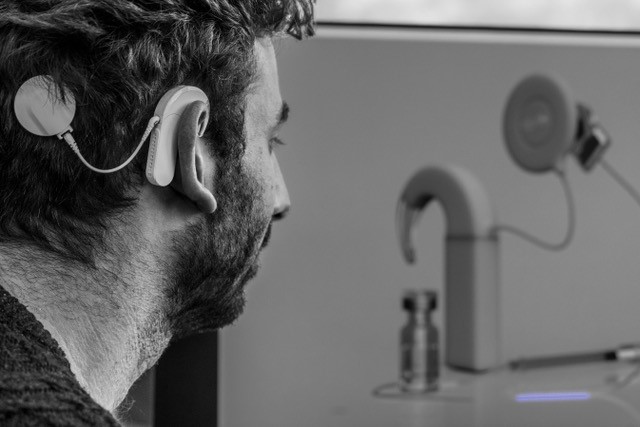Researchers at the Institute for Bioengineering of Catalonia (IBEC) in Spain and the University Medical Center Göttingen in Germany achieve, for the first time, in vivo light-activated auditory stimulation without the need for genetic manipulation. This new light-controlled drug, capable of triggering the neural pathways involved in hearing, can contribute to improving the spectral resolution of cochlear implants used by people with profound hearing loss or deafness.

Currently, approximately 1 million people around the world use a cochlear implant, a surgically implanted device which restores sound perception in case of profound hearing loss or deafness. Microphones on the outside of the device convert sound into electric signals that then directly stimulate the auditory nerve in the cochlea, the structure in the inner ear involved in hearing (it transforms sounds into nervous messages and sends them to the brain).
Although cochlear implants have been highly successful in recovering understanding of speech in the quiet, because of the limited spectral resolution users have difficulty following conversations in background noise and limited music appreciation.
Now, a recent publication in the prestigious Journal of the American Chemical Society (JACS) brings us a step closer to a new generation of cochlear implants that could overcome these limitations.
“We were able to verify that our light-activated drug had induced an electrophysiological response in the cochlea – the first time that any experiment has done so using a pharmacological route.”
Garrido-Charles
Researchers at the Institute for Bioengineering of Catalonia (IBEC), in collaboration with scientists of the Cluster of Excellence “Multiscale Bioimaging: From Molecular Machines to Networks of Excitable Cells” (MBExC) at the University Medical Center Göttingen (UMG), Germany, the CIBER-BBN, and the Consejo Superior de Investigaciones Científicas – Institute for Advanced Chemistry of Catalonia (IQAC-CSIC), developed, for the first time, a light-controlled pharmacological agent that was used to photoactivate auditory neurons in adult gerbils and could ultimately contribute to improving the spectral resolution of cochlear implants.
The study was senior-authored by Pau Gorostiza, ICREA Research Professor and Group Leader of the Nanoprobes and nanoswitches group at IBEC, and Tobias Moser, director of the Institute for Auditory Neuroscience at the UMG and spokesperson of the MBExC.
Better hearing restoration
To develop this light-controlled drug, the researchers teamed up with optogenetics experts at the Institute for Auditory Neuroscience. This technique uses genetic manipulation to control neurons with light and couple their activity to a light-emitting cochlear implant. “Tobias Moser’s group has pioneered research in this area, and they have successfully restored hearing with light by genetically modifying spiral ganglion neurons,” explains Gorostiza.
“On the contrary, in this current study, we developed an alternative route to couple light and electrical activity in the neurons that doesn’t involve genetic manipulation. We have developed a compound that chemically attaches to a neuroreceptor protein like a ‘molecular prosthesis’ and activates the neurons when illuminated,” adds Carlo Matera, co-first author that synthesized the drug. Having multiple routes available for the use of the optical cochlear implant will provide access to this technology to a wider range of potential users.
Light-activated neural control overcomes some of the shortcomings of cochlear implants powered by electrical stimulation. “The main reason that implant users struggle to perceive music and speech in loud settings is that the cochlea is filled with fluid. When you use electricity to stimulate it, there is a huge spread of excitation,” explains co-first-author Antoine Huet, researcher at the UMG and MBExC Junior Fellow. “Since light can be better confined in liquid, our technique can stimulate the neurons in the cochlea with much greater precision,” he points out.
“Our computer and preliminary experiments show us that hearing the light has the potential to restore near-physiological hearing. There are still several milestones to meet before the first in man trial can be initiated.” concludes Huet.
This would mean that users would experience a recovery of “near-physiological hearing” in these complex hearing situations. “For conversations in background noise and music appreciation, the key is to have excellent frequency resolution in the sound, and this cannot be achieved with electrical stimulation,” he adds.
First-of-its-kind drug
The researchers designed a compound that could be activated by a single wavelength of blue light. “Once we had tested and characterized the compound in vitro in hippocampal neurons, we carried out in vivo experiments in gerbils, small rodents” says co-first author Aida Garrido-Charles researcher at IBEC and the UMG.
In future studies, the teams will make further improvements to the drug and test how closely it restores hearing.
Reference article: Aida Garrido-Charles, Antoine Huet, Carlo Matera, Anupriya Thirumalai, Amadeu Llebaria, Tobias Moser, Pau Gorostiza. Fast photoswitchable molecular prosthetics control neuronal activity in the cochlea. Journal of the American Chemical Society (2022), https://doi.org/10.1021/jacs.1c12314.





